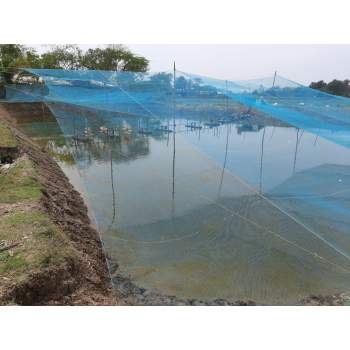- Water Quality plays an important role in the productivity of shrimp culture. Maintaining the water transparency at desirable levels (25-35 cm) is crucial to enhance the survival and growth of shrimp. Transparency refers to the penetration of light through water, which indicates the concentration of suspended solids.
- Suspended solids which make water turbid in shrimp culture systems include plankton blooms, flocculated organic matter, chemical precipitates, and sediment stirred up from the bottom of the pond.
- Turbidity due to both plankon density and suspended silt and clay particles can be measured in terms of transparency using Secchi disc. This tool is used to monitor the density of phytoplankton population. Presence of plankton blooms affect the sediment quality leading to release of toxic gases like ammonia in to the pond water.
- A secchi disk is a black and white disk that is lowered into the water until it can no longer be seen; that depth (secchi depth) is then recorded as a measure of the transparency of the water (inversely related to turbidity).
- There is a high correlation between secchi disc visibility and phytoplankton (water colour) density.
- Secchi disc visibility is the average of the depth at which a disc, a round plate with alternating black and white quadrants disappears and reappears from view when sunlight is intense or moderate. The optimum range for secchi disc reading is between 30 and 60 cm to the juvenile stage and between 25 and 40 cm to the sub-adult and final stage.
- High value of transparency (>60 cm) is indicative of poor plankton density and therefore water should be fertilized with right kind of fertilisers.
- Low value of transparency indicates high density of plankton and hence fertilization rate and frequency should be reduced.
- High secchi disc reading is associated with low productivity of the pond and low secchi disc reading is associated with high productivity of the pond.
- In general, high productivity ponds are having high biomass that increases oxygen consumption, which may lead to oxygen depletion.
- The optimum range of transparency is 25-35 cm.
- Transparency less than 20 indicates that the water is unsuitable for shrimp culture and should be changed immediately to flush out excess bloom.
Secchi Disc Measurement
- Secchi disc is a simple circular plate/disc with alternate segments painted black and white.
- The plate/disc is mounted at the end of a rod/stick upon which distances are marked with zero being at the plate end.
- To take transparency measurements a farmer can either stand on walkway platform or at the edge of the dike and lower the secchi disc holding the end of the stick slowly into the water.
- The depth at which the black and white segments of the disc disappear is the secchi disc reading.
Application of zeolites and water exchange are routine practices in shrimp culture to control the turbidity.
























